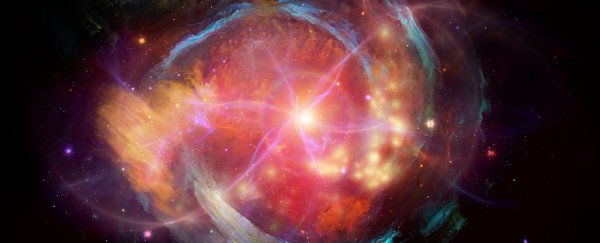Today our middle-aged Universe looks eerily smooth. Too smooth, in fact.
While a rapid growth spurt in space-time would explain what we see, science needs more than nice ideas. It needs evidence that whittles away contending arguments. We might finally know where to look for some.
A team of physicists from the Centre for Astrophysics | Harvard & Smithsonian (CfA) and Harvard University went back to the drawing board on the early Universe's evolution to give us a way to help those inflation models stand out from the crowd.
"The current situation for inflation is that it's such a flexible idea, it cannot be falsified experimentally," says theoretical physicist Avi Loeb from the CfA.
"No matter what value people measure for some observable attribute, there are always some models of inflation that can explain it."
We've been convinced for some time that our Universe is expanding – its fabric slowly stretching out under the influence of some kind of strange 'dark' energy.
If we press rewind on the Universe until it was barely 10-43 seconds old, we arrive at the limit of what our knowledge of physics can handle. Before that moment? Geometry is so nuts, we just don't know where to start.
Running the calculations backward, we also find the Universe would have had a radius of 10-10 metres at this crucial moment. That sounds tiny, sure, but it's not tiny enough.
The light echo of the Universe's first moments are still visible in the form of a cosmic microwave background. Oddly, this background radiation looks surprisingly uniform today.
Thermodynamics makes this observation hard to swallow. Such uniformity means radiation was zipping from one edge of the Universe to the other, balancing out temperature fluctuations. Yet space was expanding too fast for light to keep up.
For such a balancing act to be remotely feasible, the radius of the newborn Universe at that critical moment had to be magnitudes smaller.
This itty-bitty cosmos would have shot through early childhood at an exponential rate, blowing up to the size of a grain of sand in a few ten-thousandths of a second.
The story neatly fits what we observe, but so would other explanations where the Universe didn't quickly blow apart at the seams.
"In some alternative theories, the size of the Universe contracts. Some do it very slowly, while others do it very fast," says Harvard physicist Zhong-Zhi Xianyu.
"The attributes people have proposed so far to measure usually have trouble distinguishing between the different theories because they are not directly related to the evolution of the size of the primordial Universe."
Did time even exist before the Big Bang? Was there some kind of reverse Universe? Everybody is welcome to their pet theory on how our Universe came to look as it does, but only one can be a winner.
To help decide which ones stay and which ones go, the researchers proposed using observable attributes that we can link with discriminating features of inflation-based models.
The challenge is knowing how to interpret such observations as a sequence of events. What's needed is some sort of standardised cosmic time stamp to tease out relevant steps, some of which could potentially rule out inflation altogether.
"If we imagine all of the information we learned so far about what happened before the Big Bang is in a roll of film frames, then the standard clock tells us how these frames should be played," says CfA's Xingang Chen.
The team suggests a mechanism by which quantum fluctuations can hint at sequences of events that are reflected in the patterns of vast cosmic structures.
"These signals will be very subtle to detect," says Chen.
"The cosmic microwave background radiation is one such place, and the distribution of galaxies is another. We have already started to search for these signals and there are some interesting candidates already, but we need more data."
Other cosmologists have also suggested searching for hints of our Universe's hidden past in the swirls of light and matter in the sky.
Some point to possible 'scars' left by a previous universe's black holes on our cosmic microwave background. Others predict we might find signs that the physics-breaking boundary we call the Big Bang never happened.
There are a lot of interesting ideas out there explaining how our Universe evolved. Now we just need to work out which ones we can throw into the 'nice idea, shame about the facts' file.
This research has been accepted for publication by Physical Review Letters.
